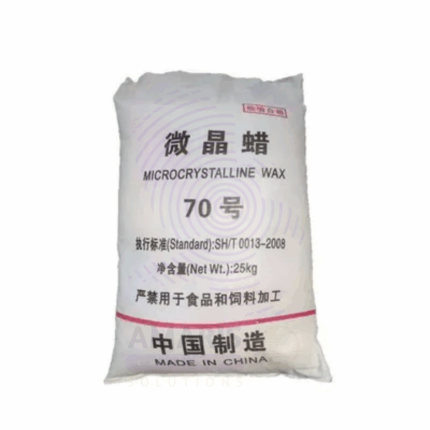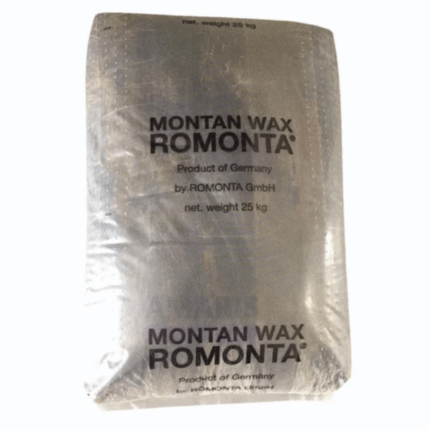“Polyvinyl Alcohol” has been added to your cart. View cart
Snow White Microwax
Whatsapp Order
Snow White Microwax is a refined, high-purity microcrystalline wax with a bright white color and fine crystalline structure. It is derived from petroleum and modified to enhance flexibility, adhesion, and water resistance. This wax is widely used in industries requiring a blend of hardness and elasticity, along with excellent binding and coating properties. Its low odor and neutral pH make it suitable for sensitive applications, including cosmetics and food packaging.
Description
Table of Contents
Toggle
Uses
Primary Uses
- Cosmetics & Personal Care
- Acts as a binding agent in lipsticks, creams, and mascaras for texture stability.
- Provides gloss and structure to balms, pomades, and hair waxes.
- Improves water resistance in lotions and sunscreens.
- Candles
- Enhances rigidity and burn time in blended candle formulations.
- Reduces frosting (white crystalline spots) in paraffin candles.
- Packaging Coatings
- Coats paper, cardboard, and films for moisture and grease resistance (e.g., food packaging).
- Used in hot-melt coatings for carton sealing.
- Adhesives & Sealants
- Modifies flexibility and tack in hot-melt adhesives.
- Seals porous surfaces in wood and leather treatments.
- Polishes & Coatings
- Key ingredient in shoe, floor, and automotive polishes for shine and protection.
- Forms protective layers on metals and furniture.
- Pharmaceuticals
- Binds tablets and controls drug release rates in coatings.
- Seals capsules and ointments for stability.
Secondary Uses
- Art & Crafts
- Used in encaustic painting (pigment binding for wax-based art).
- Protects sculptures and murals from humidity.
- Textiles
- Waterproofing agent for fabrics and threads.
- Softening agent in leather conditioning.
- Rubber & Plastics
- Anti-blocking agent in plastic films.
- Processing aid in rubber compounding.
- Food Industry
- Coating for cheeses and fruits (FDA-approved grades only).
- Glazing agent for confectionery (e.g., chewing gum).
- Electronics
- Insulating material for capacitors and cables.
- Moisture barrier in circuit board coatings.
- Agriculture
- Coating for fertilizers to control nutrient release.
- Protects tree grafts from pests and drying.
PRODUCT KEY FEATURES
Basic Identification Attributes
- Chemical Name (IUPAC): Hydrocarbons, C20–50 (microcrystalline wax).
- Common/Trade Names: Microwax, Multiwax, White Petroleum Wax.
- CAS Number: 63231-60-7 (general for microwax).
- HS Code: 3404.90 (Waxes, not emulsified).
- Synonyms: Microcrystalline paraffin, amorphous wax.
Physical & Chemical Properties
- Physical State: Solid (pellets, flakes, or blocks).
- Color & Odor: Snow white; odorless.
- Melting Point: 60–90°C (varies by grade).
- Solubility: Insoluble in water; soluble in oils, chloroform, and toluene.
- Density: 0.92–0.94 g/cm³.
Safety & Hazard Attributes
- GHS Classification: Non-hazardous (typically).
- Toxicity: Low; non-irritating to skin (cosmetic-grade).
- Exposure Limits: N/A (generally safe for handling).
Storage & Handling Attributes
- Storage Conditions: Cool, dry place (<30°C); away from oxidizers.
- Container Type: Paper bags, cartons, or polyethylene-lined drums.
- Shelf Life: 2–5 years if stored properly.
- Handling Precautions: Use gloves to avoid contamination; no ventilation needed.
Regulatory & Compliance Attributes
- Complies with FDA 21 CFR 172.886 (food-grade), EU Cosmetics Regulation (EC 1223/2009).
- REACH registered; meets USP/NF standards for pharmaceuticals.
Environmental & Health Impact
- Biodegradability: Slow; petroleum-derived but non-toxic.
- Ecotoxicity: Low; minimal aquatic toxicity.
- Bioaccumulation: Negligible.
SAFETY HANDLING PRECAUTIONS
Safety Handling Precautions
- PPE Required: Gloves (for hygiene, not safety).
- Handling Guidelines: Avoid dust formation; no special ventilation required.
First Aid Measures
- Inhalation: Unlikely; move to fresh air if discomfort occurs.
- Skin Contact: Wash with soap and water.
- Eye Contact: Rinse with water for 15 minutes.
- Ingestion: Rinse mouth; seek medical advice if large quantities are swallowed.
Firefighting Measures
- Fire Hazards: Combustible at high temperatures.
- Extinguishing Media: CO₂, foam, or dry chemical.
- Hazardous Combustion Products: CO, CO₂, smoke.
Related products
Bubble Gum Fragrance Oil
Bubble Gum Fragrance Oil is a high-quality aromatic oil designed to impart the classic sweet, fruity, and nostalgic scent of bubble gum. This fragrance oil is widely used in a variety of personal care and household products to provide a fun and playful aroma. It is carefully formulated for stability and long-lasting scent performance, making it ideal for use in soaps, candles, air fresheners, and cosmetic formulations.
Methoxy benzophenone Sulfonic Acid
Methoxy Benzophenone Sulfonic Acid is a water-soluble UV filter widely used in sunscreen and cosmetic formulations. It absorbs ultraviolet (UV) radiation, primarily in the UVB range, protecting skin and products from harmful effects of sun exposure. This compound appears as a white to off-white powder or crystalline solid and is valued for its photostability and broad-spectrum UV protection.
Methyl Paraben
Methyl Paraben is a white to off-white crystalline powder widely used as an antimicrobial preservative in cosmetics, pharmaceuticals, and food products. It is a member of the paraben family of preservatives known for their effectiveness against a broad spectrum of bacteria and fungi. Methyl Paraben helps extend the shelf life of products by preventing microbial growth without affecting the product's texture or color.
Methyl Salicylate BP
Methyl Salicylate BP is a clear, colorless to pale yellow oily liquid with a characteristic strong, sweet, and minty odor. It is an organic ester commonly used for its analgesic, anti-inflammatory, and flavoring properties. Methyl Salicylate is widely used in pharmaceutical preparations, topical pain relief products, cosmetics, and as a fragrance ingredient.
Methylene Glycol
Product Description
Methylene Glycol is a chemical compound formed by the reversible reaction of formaldehyde with water. It exists in equilibrium with formaldehyde in aqueous solutions and is commonly used as a disinfectant, preservative, and industrial biocide. Due to its antimicrobial properties, it is widely applied in water treatment, cosmetics, and embalming fluids.Micro crystalline Wax
Montan Wax
Montan Wax is a hard, brittle, natural fossil wax derived from lignite or brown coal deposits. It is composed primarily of long-chain fatty acids, esters, and hydrocarbons. Montan Wax is valued for its excellent lubricating, polishing, and emulsifying properties. It is widely used in various industrial applications including coatings, polishes, plastics, and as an additive in rubber and adhesives to improve surface finish and performance.
Natural Beta carotene food grade
Natural Beta Carotene Food Grade is a naturally derived carotenoid pigment obtained from sources such as algae, carrots, palm oil, and other vegetables. It is a powerful antioxidant and a precursor to vitamin A (provitamin A), essential for human health. This bright orange-red pigment is widely used as a natural colorant in food, beverages, dietary supplements, and cosmetics. Its antioxidant properties help protect cells from oxidative damage, supporting immune function, eye health, and skin vitality.


 Preservatives(food)
Preservatives(food) Flavor Enhancers
Flavor Enhancers Acidulants
Acidulants Sweeteners
Sweeteners Antioxidants
Antioxidants Colorants(food)
Colorants(food) Nutraceutical Ingredients (food)
Nutraceutical Ingredients (food) Nutrient Supplements
Nutrient Supplements Emulsifiers
Emulsifiers
 Collectors
Collectors Dust Suppressants
Dust Suppressants Explosives and Blasting Agents
Explosives and Blasting Agents Flocculants and Coagulants
Flocculants and Coagulants Frothers
Frothers Leaching Agents
Leaching Agents pH Modifiers
pH Modifiers Precious Metal Extraction Agents
Precious Metal Extraction Agents
 Antioxidants(plastic)
Antioxidants(plastic) Colorants (Pigments, Dyes)
Colorants (Pigments, Dyes) Fillers and Reinforcements
Fillers and Reinforcements Flame Retardants
Flame Retardants Monomers
Monomers Plasticizers
Plasticizers Polymerization Initiators
Polymerization Initiators Stabilizers (UV, Heat)
Stabilizers (UV, Heat)
 Antifoaming Agents
Antifoaming Agents Chelating Agents
Chelating Agents Coagulants and Flocculants
Coagulants and Flocculants Corrosion Inhibitors
Corrosion Inhibitors Disinfectants and Biocides
Disinfectants and Biocides Oxidizing Agents
Oxidizing Agents pH Adjusters
pH Adjusters Scale Inhibitors( water)
Scale Inhibitors( water)
 Antioxidants(cosmetic)
Antioxidants(cosmetic) Emollients
Emollients Fragrances and Essential Oils
Fragrances and Essential Oils Humectants
Humectants Preservatives
Preservatives Surfactants(cosmetic)
Surfactants(cosmetic) Thickeners
Thickeners UV Filters
UV Filters
 Fertilizers
Fertilizers Soil Conditioners
Soil Conditioners Plant Growth Regulators
Plant Growth Regulators Animal Feed Additives
Animal Feed Additives Biostimulants
Biostimulants Pesticides (Herbicides, Insecticides, Fungicides)
Pesticides (Herbicides, Insecticides, Fungicides)
 Active Pharmaceutical Ingredients (APIs)
Active Pharmaceutical Ingredients (APIs) Excipients
Excipients Solvents(pharmaceutical)
Solvents(pharmaceutical) Antibiotics
Antibiotics Antiseptics and Disinfectants
Antiseptics and Disinfectants Vaccine Adjuvants
Vaccine Adjuvants Nutraceutical Ingredients (pharmaceutical)
Nutraceutical Ingredients (pharmaceutical) Analgesics & Antipyretics
Analgesics & Antipyretics
 Analytical Reagents
Analytical Reagents Solvents(lab)
Solvents(lab) Chromatography Chemicals
Chromatography Chemicals Spectroscopy Reagents
Spectroscopy Reagents microbiology-and-cell-culture-reagents
microbiology-and-cell-culture-reagents Molecular Biology Reagents
Molecular Biology Reagents Biochemical Reagents
Biochemical Reagents Inorganic and Organic Standards
Inorganic and Organic Standards Laboratory Safety Chemicals
Laboratory Safety Chemicals Specialty Laboratory Chemicals(Special Laboratory Equipment)
Specialty Laboratory Chemicals(Special Laboratory Equipment)
 Demulsifiers
Demulsifiers Hydraulic Fracturing Fluids
Hydraulic Fracturing Fluids Scale Inhibitors(oil)
Scale Inhibitors(oil) Surfactants(oil)
Surfactants(oil) Drilling Fluids
Drilling Fluids
 Dyes and Pigments
Dyes and Pigments Bleaching Agents
Bleaching Agents Softening Agents
Softening Agents Finishing Agents
Finishing Agents Antistatic Agents
Antistatic Agents
 Admixtures
Admixtures Waterproofing Agents
Waterproofing Agents Sealants and Adhesives
Sealants and Adhesives Curing Compounds
Curing Compounds Concrete Repair Chemicals
Concrete Repair Chemicals Anti-Corrosion Coatings
Anti-Corrosion Coatings
 Surfactants(cleaning)
Surfactants(cleaning) Builders
Builders Enzymes
Enzymes Solvents (Cleaning)
Solvents (Cleaning) Fragrances
Fragrances
 Electronic Chemicals
Electronic Chemicals Catalysts
Catalysts Lubricants
Lubricants Photographic Chemicals
Photographic Chemicals Refrigerants
Refrigerants Automotive chemicals
Automotive chemicals Pyrotechnic Chemicals
Pyrotechnic Chemicals
 Biodegradable Surfactants
Biodegradable Surfactants Bio-based Solvents
Bio-based Solvents Renewable Polymers
Renewable Polymers Carbon Capture Chemicals
Carbon Capture Chemicals Wastewater Treatment Chemicals
Wastewater Treatment Chemicals
 Pigments
Pigments Solvents(paint)
Solvents(paint) Specialty Coatings
Specialty Coatings Binders/Resins
Binders/Resins Additives
Additives Driers
Driers Anti-Corrosion Agents
Anti-Corrosion Agents Functional Coatings
Functional Coatings Application-Specific Coatings
Application-Specific Coatings
 Fresh Herbs
Fresh Herbs Ground Spices
Ground Spices Whole Spices
Whole Spices Spice Blends
Spice Blends Dried Herbs
Dried Herbs
 Leavening Agents
Leavening Agents Dough Conditioners
Dough Conditioners Flour Treatments
Flour Treatments Fat Replacers
Fat Replacers Decoratives
Decoratives Preservatives(baking)
Preservatives(baking)
 Plasticizers & Softeners
Plasticizers & Softeners Reinforcing Agents
Reinforcing Agents Adhesion Promoters
Adhesion Promoters Vulcanizing Agents
Vulcanizing Agents Antidegradants
Antidegradants Blowing Agents
Blowing Agents Fillers & Extenders
Fillers & Extenders Accelerators & Retarders
Accelerators & Retarders
























